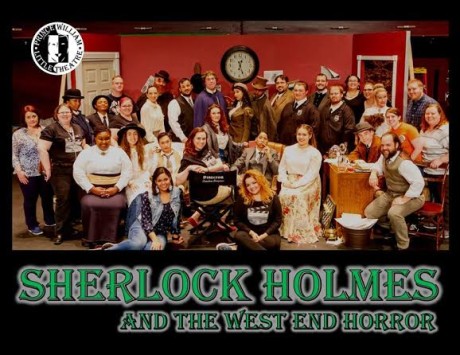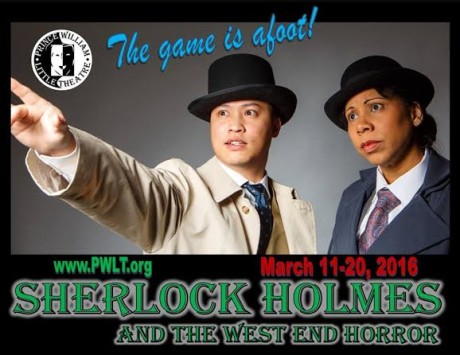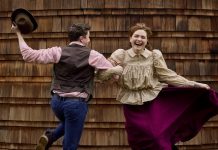“Yet another Sherlock Holmes play?” you might say. Yes, but with a twist – Prince William Little Theatre’s production of Sherlock Holmes and the West End Horror is anything but same-old, same-old. Director Caroline Simpson, the designers, and the large, thoroughly engaged cast have created a stage spectacle that is queerly beautiful as well as a fabulous entertainment.

Photo by David Harback of Harback Photography.
The play isn’t based on one of the classic Arthur Conan Doyle stories, but on a 1976 novel – The West End Horror – written by film director, screenwriter, and Holmes pasticher Nicholas Meyer, whose other credits include Invasion of the Bee Girls and Star Trek II: The Wrath of Khan. I haven’t read the original novel, so I can’t comment on its faults or virtues; however, as a script — adapted to the stage by Marcia Milgrom Dodge and Anthony Dodge — it’s not that good. Not dreadfully bad, mind you, just mediocre, rather flat. However, the script is full of potentially interesting episodes – which PWLT’s production exploits advantageously. It centers on the mysterious murder of a theater critic. The case is brought to the attention of Holmes and Watson by none other than George Bernard Shaw (supposedly) before he hits it big.
One of the conceits of this production is that the audience is there to witness the taping of a Sherlock Holmes show. Thus we see onstage, throughout the performance, an entire film crew as a kind of second cast. This a very clever directorial touch for at least three reasons. One, it allows for greater continuity of stage action than the episodic, scene-shifting script would otherwise permit. Two, the inter-action episodes become the occasion for odd, frequently hilarious interactions among the cast and crew. And three, it allows for a self-conscious, deliberately mannered approach to the material that in large part neutralizes the weakness of the script. As a result, the material, gaining in strength, becomes theatrically compelling.
The design elements of the show are rather splendid, in a corny, low-budget way. Film projection is used, along with a portable green screen. The backdrops are extensive, moveable, and lovingly fashioned – I was impressed by the craftsmanship and the obvious effort put into every facet of this production. There is extensive use of music, some of which is prerecorded and some of which is sung on stage. Pieces are by Elgar, Gilbert and Sullivan, and Edward German. Peter Ponizini’s exuberant lighting design adds excitement and is here and there coupled with the music and stage action to haunting, quite beautiful effect. The costumes and props (by Michelle Matthews and Sarah Barlow, respectively) tie us in effectively, humorously, sometimes grotesquely, to the gritty, foggy streets and cluttered chambers of Holmesian London. Set design is by James Maxted and Christine Laird, sound design by Matthew Scarborough, and videography by Caroline Simpson.
What about the acting? First, I applaud the whole cast – they do a great job. There are twenty-four credited performers in the show, and it’s obvious I can’t mention every one of them. So I’ll point to a few highlights, in no particular order:
In an odd twist, two Mrs. Hudsons have been cast. Mrs. Hudson is Holmes’ and Watson’s landlady. Between scenes, the actresses vie with each other as to who will perform the role that night. In the end, they both get on stage, Tashina Harris as Mrs. Hudson #1, Amy Treat as Mrs. Hudson #2.
I don’t know how well the beardless Matt Crush represents the historical Bernard Shaw, before fame or not. The script marks the world-famous wit, the clever thinker and master of the English language (as it is said, only the Irish are) as a nigh inarticulate, clumsy sort of oaf. This is almost a good thing. The historical Shaw was funny yet a rather miserable chap – but Mr. Crush’s character is downright endearing.
Matthew Scarborough steps down twice from the production booth to assume the role of a reluctant actor, put upon at the last minute to play Oscar Wilde, even though he “doesn’t look like him.” In doing so, he steals the show – or at least the scenes he’s in. Incidentally — as Mark Antony — Scarborough stole the show in Julius Caesar last fall, as well. He is a gifted comedian with a vibrant stage presence.
Tegan Cohen and Jared Dent also shine in comic roles, as theatre stars Ellen Terry and Henry Irving, respectively. They primp before the camera, strutting and declaiming with flair.
There are weird cameos by Arthur Sullivan (of Gilbert and Sullivan), played by Eric Verchot-Ware, and Bram Stoker, and Dracula – played by Devyn Tinker. The scene from Dracula, mostly pre-filmed and projected, is disturbing, graphic, and rendered with clever zeal.
As the bumbling constable Stanley Hopkins, AnuRa Harrison gets a laugh with almost every gesture or sound she makes on stage. She doubles as murder suspect Achmed Singh, playing him with a slight innocence and a noirish edge. Leslie Barnett is Hopkins’ bubling superior, Inspector LeStrade.
In the most haunting scene of the play, Jason Aaron Foster plays Dr. Benjamin Eccles coming to his ultimate end, a demise that affects one at the visceral level; it’s visually striking, gross, and – in the most hammy way – dramatic. Foster excels at the undertaking, gruesome as it may be.
What about Sherlock Holmes, himself, and Doctor Watson? They are good, too. The dynamic between them is a little different than normal, but this works itself into the overall weirdness of the play.
Sherlock Holmes (Khoa Pham) is, so far as I am aware, generally known to be clinically detached, preternaturally calm, objective, and unfazed. Mr. Pham’s character is rather dull, most always harried, more than not seemingly at his wit’s end. It’s a topsy-turvy kind of Sherlock, but it works in its way – and once you accept that this Holmes is a little different, you will like Khoa Pham in the role. He is funny – also, charming.

Sonia Bronder plays Holmes’ sidekick, Dr. John Watson. She brings to the role a good humor, lively expressions, and intelligence. In fact, in Sherlock Holmes and the West End Horror, Watson is on a par with Holmes in every way – they are partners in crime-solving, more than a haughty intellect accompanied by its more down-to-earth friend.
PWLT’s rendering of Sherlock Holmes and the West End Horror is a surrealistic little gem. It’s flamboyant and meets the audience on peculiar terms. Highly recommended.
Running Time: Two hours and 45 minutes, including a 15-minute intermission.
Sherlock Holmes and the West End Horror plays from March 11-20, 2016 at Prince William Little Theatre performing at Hylton Performing Arts Center – in the Gregory Theatre – 10960 George Mason Circle, in Manassas, VA. For tickets, call (888) 945-2468 from 10:00 AM to 9:00 PM, (service charge added), or purchase them online.
LINK:
Meet Cast Members, The Director, and Designers of Prince William Little Theatre’s ‘Sherlock Holmes and the West End Horror’ Playing 3/11-20 at Hylton Performing Arts Center.
RATING:





